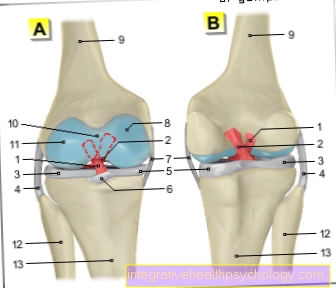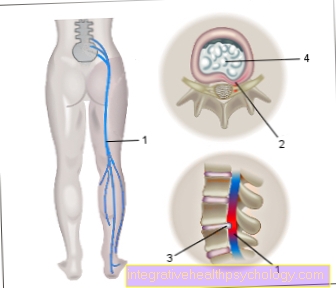D dimers
introduction
D-dimers are proteins that are created when a thrombus is dissolved. These are fibrin breakdown products that circulate freely in the blood. Its value is determined above all if a thrombosis is suspected. However, its informative value is limited. A high value of the D-dimers can have many causes and does not clearly prove the presence of a thrombosis. Conversely, if the value is negative, a thrombosis can be ruled out with a high degree of probability.
Read more on the subject at: Detect thrombosis

What are D-Dimers?
Various substances are involved in blood clotting. One of them is the protein fibrin, the breakdown products of which can be measured in the blood. If a blood clot forms in the vascular system, it is dissolved within a short time. Plasmin is responsible for its dissolution, it is an enzyme that splits fibrin and fibrinogen. The resulting cleavage products of the fibrin are then referred to as D-dimers.
Causes of increased D-dimer levels
The level of D-dimers in the blood can be increased for various reasons.
Most often, it is determined to rule out life-threatening pulmonary embolism. The cause is usually a deep vein thrombosis in the leg, in which the blood clot detaches and enters the fine vessels of the lungs with the blood.
In the case of one disseminated intravascular coagulopathy (DIC), the value of the D-dimers is also outside the reference range. This is an excessive consumption and subsequent lack of coagulant substances within the vessels.
An increase can also be observed in connection with a cardiac event (e.g. heart attack), blood poisoning, tumor disease, liver cirrhosis, leukemia, pregnancy and after surgery.
What can be the causes of permanently slightly elevated D-dimers?
The causes of permanently slightly elevated D-dimer values can be very diverse. For this reason, no disease can be assigned unequivocally to a positive test for D-dimers.
Pneumonia and COPD are possible causes of such slightly elevated values. COPD is a disease of the lungs with permanently narrowed airways. In addition, slightly increased D-dimer values are also measured in numerous cancers. Operations and injuries in which tissue damage has occurred are another cause of slightly increased values. In addition, there are myocardial infarctions, liver cirrhosis and kidney failure. Severe inflammations that cause sepsis or lead to hemolytic uremic syndrome can also be such a cause. Sepsis describes an unstable circulation as a result of inflammation. The hemolytic-uremic syndrome is a breakdown of red blood cells that are excreted through the kidneys and damage them.
In addition to these diseases, there are normal and healthy changes in the body as a result of menstruation, pregnancy or advancing age. There are also many drugs that deliberately increase the breakdown of fibrin and therefore lead to an increase in fibrin breakdown products, namely the D-dimers. In addition to these causes for a permanent slight increase in D-dimers, there are also diseases such as deep vein thrombosis or pulmonary embolism, which often have very high values for the D-dimers. However, measurements in the early stages or in the case of less pronounced disease can also lead to only slightly increased values in the blood.
What drugs increase D-dimers?
The most important drugs that cause an increase in D-dimers are those that deliberately increase the breakdown of fibrin. These drugs are used in heart attacks, strokes, pulmonary embolisms, and deep vein thrombosis to dissolve the blood clot that is causing them. This improves the blood flow and thus the oxygen supply to the affected areas of the body, so that they only suffer less damage. These drugs are urokinase and streptokinase, as well as the recombinant tissue plasmin activator, also called rt-PA or alteplase. In addition, there is the drug heparin, whose function is to counteract the formation of a blood clot. In some cases, however, the complication of "heparin-induced thrombocytopenia type 2" occurs during treatment with heparin. A general coagulation activity takes place here, due to which there is a consumption of blood platelets and also an increase in D-dimers in the blood.
thrombosis
In the case of a thrombosis, a blood clot forms within a vessel, which as a result hinders the undisturbed blood flow. The reason for its development can be a disturbed balance of anticoagulant and coagulation-promoting factors, an internal injury to the vessel walls or insufficient blood circulation after long immobilization.
Read more on the subject at: Thrombosis cause
pregnancy
The value of the D-dimers during pregnancy can only be assessed to a limited extent because changes in the female body cause a significant increase in the breakdown products. With the beginning of pregnancy, the D-dimers increase continuously and reach their highest level in the last few weeks before delivery. Accordingly, reference values for the D-dimers must be adjusted to rule out a thromboembolic event during pregnancy.
Thrombosis is one of the most common complications of pregnancy. Obesity, lengthy immobilization and regular vomiting promote the development of a blood clot. In more than half of the cases, the pregnancy thrombosis occurs before the 20th week. However, an increased risk remains until twelve weeks after delivery.
Read more on the subject at: Pregnancy thrombosis
D-dimer test
The D-dimers are determined using a specific antibody test. This is not only carried out to rule out a thrombosis, but also to diagnose and monitor the progress of other clinical pictures. In routine clinical practice, the D-dimers are determined indirectly using specific antibodies. These bind to a certain region of the fibrin breakdown products and lead to their agglutination (clumping). With the help of photometric measurement, a turbidity can be determined, the strength of which determines the value.
Rapid test
In the diagnosis of D-dimers, a rapid test can be used to detect D-dimers in whole blood or plasma. These are small test cassettes to which blood is applied using a pipette. The result is read off after exactly 10 minutes. If there is another red line next to the red control line in the test field, the result is positive.
In the acute situation, it enables disseminated intravascular coagulation disorder (DIC), deep vein thrombosis and pulmonary embolism to be ruled out.
D-dimer values
The D-dimer value is laboratory-specific and has the same upper limit for women and men. The value is 500 micrograms per liter.
The significance of a low D-dimer value is high. This means that pulmonary embolism, disseminated intravascular coagulopathy and deep vein thrombosis can be ruled out with a high degree of certainty.
Conversely, a high D-dimer value serves as a non-specific indication of a pathological occurrence. The exact cause must be clarified through further diagnostics.
For women, reference values are differentiated with and without taking oral contraceptives. Without it, the value is 300, with 500 micrograms per liter.
During pregnancy, the value of D-dimers increases continuously from 700 micrograms per liter in the first three months. In the second trimester of pregnancy it is around 1200 micrograms per liter and in the last few weeks before delivery it is around 2500 micrograms per liter.
False positive test result
A high D-dimer value can indicate a thromboembolic event. However, in almost 40% of the cases it is a false positive result. The value is then above the reference range without the presence of a thrombosis.
The reason for this can be influencing factors such as increased blood lipids, hemolysis and rheumatoid factors, as well as other underlying diseases.
Conversely, low D-dimers rule out the presence of a thrombosis or pulmonary embolism with a high probability.
Changes in D-dimer levels
Is there a change in D-dimer concentration with age?
The answer to this question as to whether there is a change in the D-dimer concentration in old age can clearly be answered with “yes”. As the vascular system ages, there is general coagulation activity even in a completely healthy state. This leads to permanently slightly increased D-dimer values. In order to be able to roughly estimate this falsifying factor, it is suggested to adjust the limit value for a normal value to an increased value using the formula “10 x age”. This general increase in D-dimers makes it increasingly difficult to reliably diagnose pulmonary embolism or thrombosis with age.
How does menstruation change the D-dimer value?
During menstruation there is a detachment of the mucous membrane in the uterus and thus an extensive injury. Coagulation plays a key role in protecting women from heavy bleeding. As a result of this blood clotting, the clots dissolve again and D-dimers are formed. The menstrual period in women therefore leads to increased D-dimer values even in completely healthy patients. This distorting factor should always be taken into account when interpreting the blood results.
How does the D-dimer value change in case of renal insufficiency?
In renal insufficiency, a variety of injuries and scarring of the fine vessels of the kidney lead to a loss of function. It is precisely these vascular changes that also lead to general clotting activity. As a result, D-dimers are continuously formed through the breakdown of the fibrin that has formed at the coagulation. Renal insufficiency thus leads to permanently slightly elevated D-dimer values, which should be taken into account in blood tests.
Read more on this topic at: Renal failure
What is the D-dimer value in a pulmonary embolism?
In pulmonary embolism, blood clots from a thrombosis, for example in the leg, enter the lungs via the bloodstream. These clog the fine blood vessels, which in turn leads to further clots. As a result of this strong coagulation activity in the leg and in the lungs and its breakdown products, the D-dimer value increases considerably in most cases. In some cases, however, there is only a small increase in the values. In order to diagnose or exclude a pulmonary embolism, the values of the D-dimers are important information. Because many diseases and also healthy body changes cause the D-dimers to rise, a pulmonary embolism can only be ruled out with certainty if the Values are negative, i.e. very low. Positive, i.e. increased, values only make a pulmonary embolism possible. Further investigations confirm this disease or rule it out.
Read more on this topic at: Detect pulmonary embolism
What symptoms does a D-Dimer increase cause?
The symptoms that are caused by a D-dimer increase are essentially related to the underlying disease.
The typical symptoms of a thromboembolic event include swelling of the affected part of the body, overheating, tenderness, redness and a distinct feeling of tension.
Read more on the subject at: Detect thrombosis
Pulmonary embolism is an acutely life-threatening situation that manifests itself as sudden shortness of breath and pain when inhaling. It is often accompanied by a cough, high breathing rate, fast heartbeat, and low blood pressure.
Read more on the subject at: Pulmonary Embolism Symptoms
A heart attack is characterized by strong pressure and a feeling of tightness in the area of the breastbone. One speaks of the so-called "annihilation pain", which can radiate into the arms, back and shoulder area. Those affected are also often afraid and breathless.
Read more on the subject at: Symptoms of a heart attack
therapy
Depending on the underlying cause, an adequate therapeutic measure is initiated. If the thromboembolic event is detected too late, the risk of varicose veins, post-thrombotic syndrome and pulmonary embolism increases.
If the suspicion of a thromboembolic event is confirmed, anticoagulant agents such as heparin and factor Xa inhibitors are used for dissolution.
After a thromboembolic event has already taken place, the risk of a recurrence is increased. The male sex in particular is affected by this. The vitamin K antagonist phenprocoumon (Marcumar®) and compression stockings are used for thrombosis prophylaxis in the first six months after the event. Regular checks by the doctor should take place.
Read more on the subject at: Thrombosis prophylaxis: start and duration
Thrombosis prophylaxis
A sufficient supply of fluids, approx. 1.5-2 liters of water or unsweetened tea and wearing thrombosis stockings after surgery and childbirth prevent a recurrence of a thromboembolic event.
A long immobilization phase, the combination of smoking and the use of contraceptives, and being overweight increase the risk of thrombosis. Thrombosis prophylaxis after surgery is carried out with heparin and acetylsalicylic acid (e.g. Aspirin®). Over a longer period of time, anticoagulants such as the oral anticoagulant Marcumar® are prescribed.
Read more on the subject at: Thrombosis prophylaxis postoperatively and Thrombosis prophylaxis measures





























